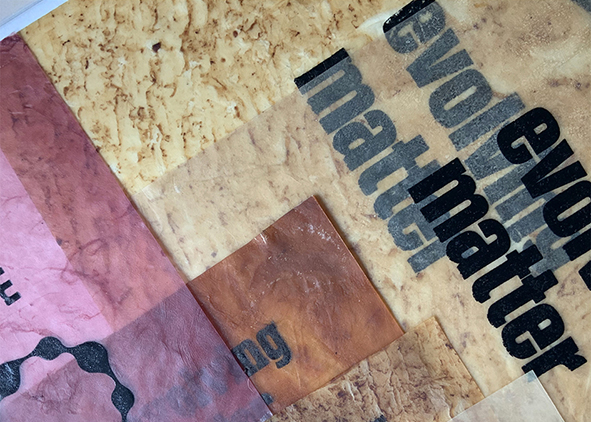Material interfaces. Biological meets digital
DOI:
https://doi.org/10.19229/2464-9309/10162021Keywords:
digital materiality, material experience, surface design, perception, biofabricationAbstract
The introduction to the concept of ‘digital materiality’ goes beyond the custom of considering matters’ physical characteristics as the opposite of virtual, binary and digital ones. Bonsiepe, in 1995, had already integrated the material characteristics of objects and the semiotic value of the interface, acknowledging its ability to become a ‘non-verbal language’, ‘spatial system’ establishing new relationships between the human body and technology. Therefore, surfaces have the key role of ‘membranes’, creating and receiving stimuli from inside and outside, and from subject and object. From this framework, it emerges the need to experiment alternative solutions meeting circularity/sustainability and experience/enjoyment needs, for example, through material interfaces or experiments on new biofabricated materials, such as microbial nanocellulose.
Downloads
Article Metrics Graph
References
Bonsiepe, G. (1995), Dall’Oggetto all’Interfaccia – Mutazione del Design, Feltrinelli, Milano.
Buci Glucksmann, C. (2004), L’art à l’époque virtuel, Collection Arts 8, L’Harmattan, Parigi.
Cytowic, R. E. (2018), Synesthesia, The MIT Press, Boston.
Dima, S., Panaitescu, D., Orban, C., Ghiurea, M., Doncea, S., Fierascu, R., Nistor, C., Alexandrescu, E., Nicolae, C., Trică, B., Moraru, A. and Oancea, F. (2017), “Bacterial Nanocellulose from Side-Streams of Kombucha Beverages Production – Preparation and Physical-Chemical Properties”, in Polymers, vol. 9, 374, pp. 1-24. [Online] Available at: doi.org/10.3390/polym9080374 [Accessed 22 September 2021].
Ferrara, M. and Lucibello, S. (2012), “Teaching material design – Research on teaching methodology about materials in industrial design”, in Strategic Design Research Journal, vol. 5, issue 2, pp. 75-83. [Online] Available at: revistas.unisinos.br/index.php/sdrj/article/view/sdrj.2012.52.03 [Accessed 29 October 2021].
Fontana, F. (2018), “L’empowerment femminile passa dai batteri – Intervista con Giulia Tommasello”, in Digicult. [Online] Available at: digicult.it/it/design/female-empowerment-goes-through-bacteria-an-interview-with-giulia-tomasello/ [Accessed 18 September 2021].
Gatenholm, P. and Klemm, D. (2010), “Bacterial Nanocellulose as a Renewable Material for Biomedical Applications”, in MRS Bulletin, vol. 35, issue 3, pp. 208-213. [Online] Available at: doi.org/10.1557/mrs2010.653 [Accessed 16 September 2021].
Gerritzen, M. and Lovink, G. (2020), Made in China, Designed in California, Criticised in Europe – Design Manifesto, BIS Publishers, Amsterdam.
Haverkamp, M. (2012), Synesthetic Design – Handbook for a multisensory approach, Birkhäuser, Basel.
Hecht, S. and Colin, K. (2003), Things That Go Unseen, Industrial Facility, London.
Jütte, R. (2004), A History of the Senses – From Antiquity to Cyberspace, Polity Press, Cambridge (UK).
Liang, H., Guan, Q., Zhu-Zhu, Song, L.-T., Yao, H., Lei, X. and Yu, S. (2012), “Highly conductive and stretchable conductors fabricated from bacterial cellulose”, in NPG Asia Materials, vol. 4, e19, pp. 1-6. [Online] Available at: doi.org/10.1038/am.2012.34 [Accessed 13 September 2021].
La Rocca, F. (2006), Il tempo opaco degli oggetti – Forme evolutive del design contemporaneo, FrancoAngeli, Milano.
Lay, M., González, I., Tarrés, J. A., Pellicer, N., Ngun Bun, K. and Vilaseca, F. (2017), “High electrical and electrochemical properties in bacterial cellulose/polypyrrole membranes”, in European Polymer Journal, vol. 91, pp. 1-9. [Online] Available at: doi.org/10.1016/j.eurpolymj.2017.03.021 [Accessed 12 September 2021].
Manovich, L. (2006), “The poetics of augmented space”, in Visual Communication, vol. 5, issue 2, pp. 219-240. [Online] Available at: doi.org/10.1177/1470357206065527 [Accessed 25 September 2021].
Manzini, E. (1986), La materia dell’invenzione – Materiali e progetto, Feltrinelli, Milano.
Tommasello, G. (2016), Bio Conductive Skin. [Online] Available at: issuu.com/giuliatomasello4/docs/bio_conductive_skin [Accessed 27 October 2021].
Zannoni, M. (2015), “Paper and Interaction – Ricerche e sperimentazioni sui nuovi oggetti cartacei interattivi”, in Acocella, A. (ed.), Paper Design, Altralinea, Firenze, pp. 42-59.

Downloads
Published
How to Cite
Issue
Section
License
This Journal is published under Creative Commons Attribution Licence 4.0 (CC-BY).
License scheme | Legal code
This License allows anyone to:
Share: copy and redistribute the material in any medium or format.
Adapt: remix, transform, and build upon the material for any purpose, even commercially.
Under the following terms
Attribution: Users must give appropriate credit, provide a link to the license, and indicate if changes were made; users may do so in any reasonable manner, but not in any way that suggests the licensor endorses them or their use.
No additional restrictions: Users may not apply legal terms or technological measures that legally restrict others from doing anything the license permits.
Notices
Users do not have to comply with the license for elements of the material in the public domain or where your use is permitted by an applicable exception or limitation.
No warranties are given. The license may not give users all of the permissions necessary for their intended use. For example, other rights such as publicity, privacy, or moral rights may limit how you use the material.


















































































